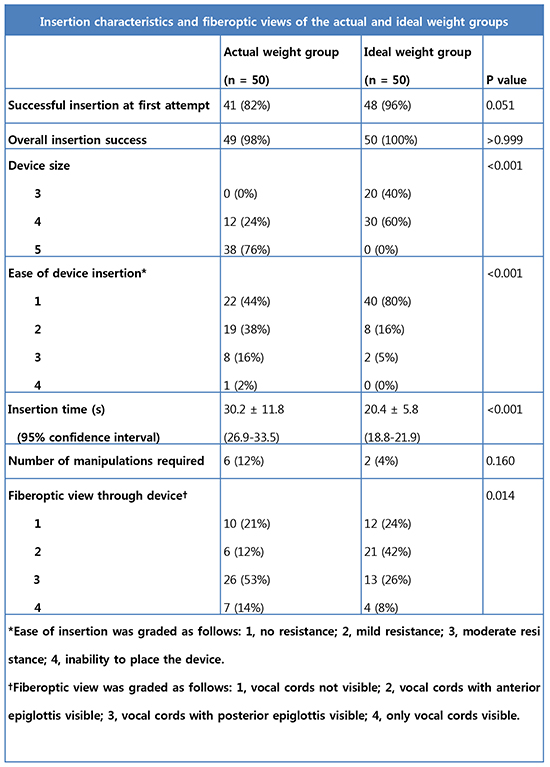1. Brimacombe J, Keller C. Laryngeal mask airway size selection in males and females: ease of insertion, oropharyngeal leak pressure, pharyngeal mucosal pressures and anatomical position. Br J Anaesth. 1999; 82:703–707.
2. Zahoor A, Ahmad N, Sereche G, Riad W. A novel method for laryngeal mask airway size selection in paediatric patients. Eur J Anaesthesiol. 2012; 29:386–390.
3. Kim HJ, Park MJ, Kim JT, Kim CS, Kim SD, Kim HS. Appropriate laryngeal mask airway size for overweight and underweight children. Anaesthesia. 2010; 65:50–53.
4. Berry AM, Brimacombe JR, McManus KF, Goldblatt M. An evaluation of the factors influencing selection of the optimal size of laryngeal mask airway in normal adults. Anaesthesia. 1998; 53:565–570.
5. Voyagis GS, Batzioulis PG, Secha-Doussaitou PN. Selection of the proper size of laryngeal mask airway in adults. Anesth Analg. 1996; 83:663–664.
6. Asai T, Howell TK, Koga K, Morris S. Appropriate size and inflation of the laryngeal mask airway. Br J Anaesth. 1998; 80:470–474.
7. Kihara S, Brimacombe JR, Yaguchi Y, Taguchi N, Watanabe S. A comparison of sex- and weight-based ProSeal laryngeal mask size selection criteria: a randomized study of healthy anesthetized, paralyzed adult patients. Anesthesiology. 2004; 101:340–343.
8. Asai T, Brimacombe J. Review article: cuff volume and size selection with the laryngeal mask. Anaesthesia. 2000; 55:1179–1184.
9. Martin SE, Mathur R, Marshall I, Douglas NJ. The effect of age, sex, obesity and posture on upper airway size. Eur Respir J. 1997; 10:2087–2090.
10. Busetto L, Calo E, Mazza M, De Stefano F, Costa G, Negrin V, Enzi G. Upper airway size is related to obesity and body fat distribution in women. Eur Arch Otorhinolaryngol. 2009; 266:559–563.
11. Pai MP, Paloucek FP. The origin of the "ideal" body weight equations. Ann Pharmacother. 2000; 34:1066–1069.
12. Meyhoff CS, Lund J, Jenstrup MT, Claudius C, Sørensen AM, Viby-Mogensen J, Rasmussen LS. Should dosing of rocuronium in obese patients be based on ideal or corrected body weight? Anesth Analg. 2009; 109:787–792.
13. Jaber S, Coisel Y, Chanques G, Futier E, Constantin JM, Michelet P, Beaussier M, Lefrant JY, Allaouchiche B, Capdevila X, et al. A multicentre observational study of intra-operative ventilatory management during general anaesthesia: tidal volumes and relation to body weight. Anaesthesia. 2012; 67:999–1008.
14. Brain A. Proper technique for insertion of the laryngeal mask. Anesthesiology. 1990; 73:1053–1054.
15. Kim MS, Lee JR, Shin YS, Chung JW, Lee KH, Ahn KR. Comparison of 2 cuff inflation methods of laryngeal mask airway Classic for safe use without cuff manometer in adults. Am J Emerg Med. 2014; 32:237–242.
16. Inagawa G, Okuda K, Miwa T, Hiroki K. Higher airway seal does not imply adequate positioning of laryngeal mask airways in paediatric patients. Paediatr Anaesth. 2002; 12:322–326.
17. Galvin EM, van Doorn M, Blazquez J, Ubben JF, Zijlstra FJ, Klein J, Verbrugge SJ. A randomized prospective study comparing the Cobra Perilaryngeal Airway and Laryngeal Mask Airway-Classic during controlled ventilation for gynecological laparoscopy. Anesth Analg. 2007; 104:102–105.
18. Asai T, Murao K, Yukawa H, Shingu K. Re-evaluation of appropriate size of the laryngeal mask airway. Br J Anaesth. 1999; 83:478–479.
19. Theiler L, Kleine-Brueggeney M, Urwyler N, Graf T, Luyet C, Greif R. Randomized clinical trial of the i-gel™ and Magill tracheal tube or single-use ILMA™ and ILMA™ tracheal tube for blind intubation in anaesthetized patients with a predicted difficult airway. Br J Anaesth. 2011; 107:243–250.
20. Van Zundert AA, Fonck K, Al-Shaikh B, Mortier E. Comparison of the LMA-classic with the new disposable soft seal laryngeal mask in spontaneously breathing adult patients. Anesthesiology. 2003; 99:1066–1071.
21. Ali A, Canturk S, Turkmen A, Turgut N, Altan A. Comparison of the laryngeal mask airway Supreme and laryngeal mask airway Classic in adults. Eur J Anaesthesiol. 2009; 26:1010–1014.
22. Lee CM, Yang HS. Case of difficult intubation overcome by the laryngeal mask airway. J Korean Med Sci. 1993; 8:290–292.
23. Brimacombe J, Keller C, Fullekrug B, Agrò F, Rosenblatt W, Dierdorf SF, Garcia de Lucas E, Capdevilla X, Brimacombe N. A multicenter study comparing the ProSeal and Classic laryngeal mask airway in anesthetized, nonparalyzed patients. Anesthesiology. 2002; 96:289–295.








 PDF
PDF ePub
ePub Citation
Citation Print
Print





 XML Download
XML Download